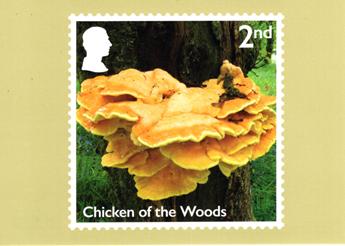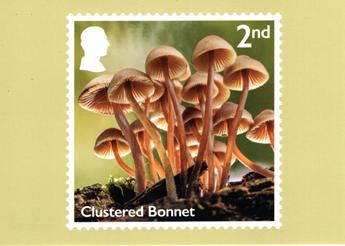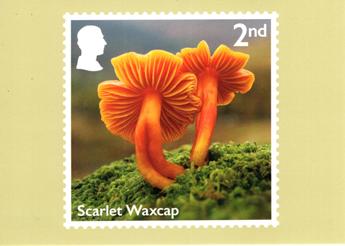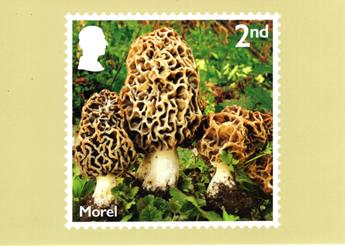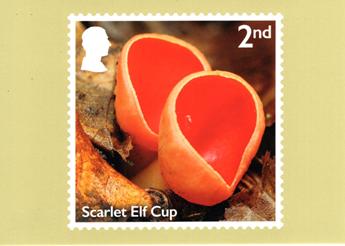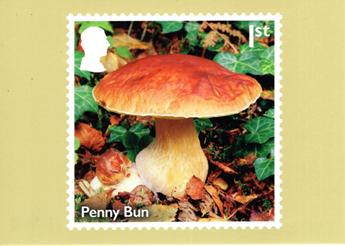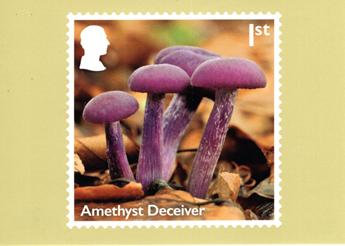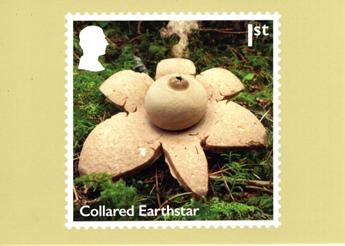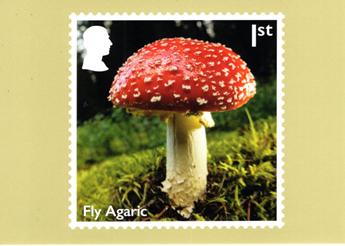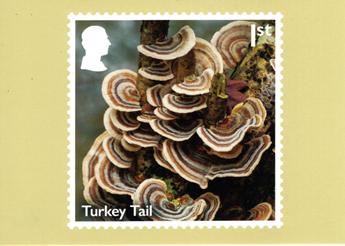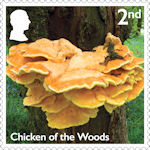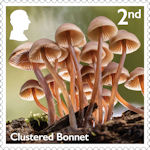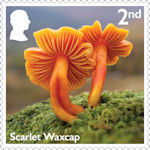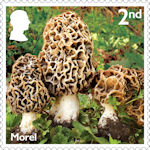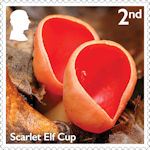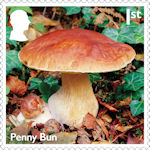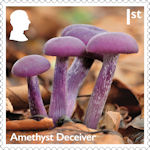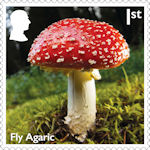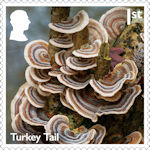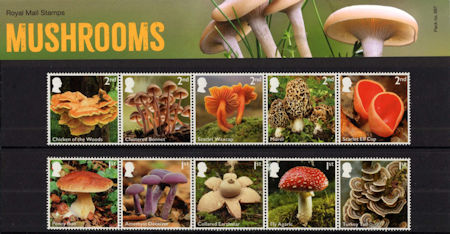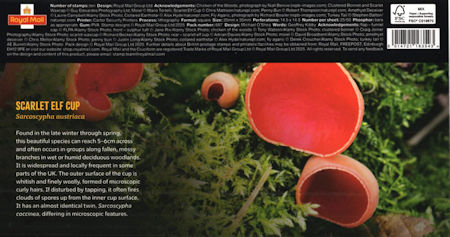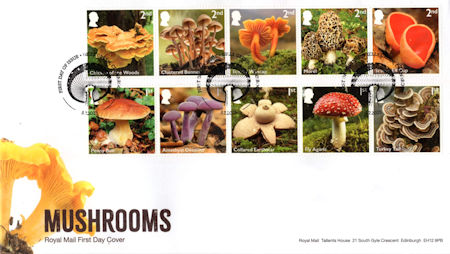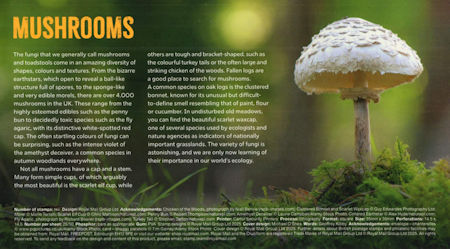Mushrooms
 Mushrooms at Royal Mail
Mushrooms at Royal Mail
Royal Mail issued 10 stamps that showcase the extraordinary diversity and ecological importance of mushrooms that can be found across the United Kingdom. Royal Mail worked with mycologist Geoffrey Kibby, one of Britain’s foremost experts on identifying mushrooms in the field. Kibby has written numerous books, which he also illustrates. He also produces field guides on the larger fungi of both Europe and North America.
2025 (July 3 2025)
Commemorative
Size 35mm (h) x 35mm (v)
Printed by Cartor Security Print
Print Process Lithography
Perforations 14.5 x 14.5
Gum PVA
Stamps
Chicken of The Woods - Laetiporus sulphureus
2ndThe common name of this popular edible mushroom relates to its texture and taste when cooked. The very large, flattened brackets, up to 50cm across, are found on standing or fallen trees, especially oaks, chestnuts and other deciduous species. The yellow to orange colours and fleshy texture make it difficult to mistake for any other mushroom. The underside of each bracket has thousands of minute pores from which the spores are ejected. This mushroom appears in the early summer and continues throughout the autumn.
Clustered Bonnet - Mycena inclinata
2ndWherever you find fallen oak logs, you may see the clustered bonnet, one the most common and widespread British species of Mycena. The reddish brown stems, paler at the top, pale grey-brown caps and rather strong odour – sometimes likened to wet paint, cucumber or flour – are good identification characteristics. Several other species of Mycena grow in clumps on logs, but this is perhaps one of the easiest to identify.
Scarlet Waxcup - Hygrocybe coccinea
2ndThis is one of the most beautiful mushrooms. Its scarlet cap can be found in late autumn in open, undisturbed, unfertilised meadows. The lamellae, or gills, on the underside of the cap and the fragile, waxy stem are both reddish-orange, with the stem being almost white at the base, while the thin reddish flesh is nearly odourless. The caps can reach up to 4cm across. There are several other red species of waxcap, differing in subtleties of colour, texture, size and smell, all best identified using a good field guide.
Morel - Morchella vulgaris
2ndMorels are found from March to May and are considered to be prized edibles. There are several very similar species, of which this is one of the more common its sponge-like head is where its spores are formed in special cells, from which they are ejected in huge numbers in a smoke-like puff. The greyish-brown head can be up to 8cm tall. When cut in half, the body is hollow. This mushroom is widespread in the UK and found in mixed woods on rich soils.
Scarlet Elf Cup - Sarcoscypha austriaca
2ndFound in the late winter through spring, this beautiful species can reach 5–6cm across and often occurs in groups along fallen, mossy branches in wet or humid deciduous woodlands. It is widespread and locally frequent in some parts of the UK. The outer surface of the cup is whitish and finely woolly, formed of microscopic curly hairs. If disturbed by tapping, it often fires clouds of spores up from the inner cup surface. It has an almost identical twin, Sarcoscypha coccinea, differing in microscopic features.
Penny Bun - Boletus edulis
1stAlso known as cep, this is one of the most famous edible mushroom species in Europe, celebrated in numerous cuisines. A robust species, it has caps that can reach 25cm across, varying from yellowish brown to dark chestnut. The fleshy stems have a fine white mesh or network on the surface, while the spongy pores on the underside of the caps are white, then yellowish. The flesh is thick, white and unchanging when cut. This fairly common mushroom can be found in the autumn in mixed woods throughout the UK.
Amethyst Deceiver - Laccaria amethystina
1stSmall troops of amethyst deceivers may appear almost as soon as the autumn rains begin. They push up through the fallen leaf litter in forests across the UK. The amethyst deceiver’s small size and striking colour when fresh of bright amethyst violet on all its parts help make it one of the easier mushrooms to identify. However, when this mushroom is old, the colour fades to a dull greyish lilac or even buff. Theviolet gills may be dusted with the white spores it produces.
Collared Earthstar - Geastrum michelianum
1stThis mushroom starts growing closed up, rather like an onion, but then the outer tissues split and fold back into star-like arms, lifting the central ball up from the ground. Inside the ball are spores that puff out when the ball is struck by rain drops or falling debris. Earthstars are fairly common in the autumn in mixed woodlands and hedgerows and can reach up to 12cm across. This mushroom is also commonly called Geastrum triplex, but that is now known to be a different species from Southeast Asia.
Fly Agaric - Amanita muscaria
1stThis is the classic toadstool illustrated in children’s books of fairy tales around the world, but many people do not realise that it is a real fungus. Widespread over the whole of the UK from around August to December, it is most commonly found in birch woods, although it will grow with other trees too. The white spots are the remains of a veil that once covered the entire fungus when young. The fly agaric is one of several poisonous species in the genus Amanita, some of which are deadly.
Turkey Tail - Trametes versicolor
1stBracket fungi, or polypores, produce bracketshaped bodies and usually grow on tree trunks or branches. One of the most common of the smaller bracket fungi found in deciduous woodlands throughout the UK, turkey tail is remarkably variable in the colour of the concentric zones, with purples, browns, greens and even bluish shades all being common. The fruiting bodies are tough but flexible, and the pale cream undersides have thousands of minute pores from which the spores are ejected.
Publicity - First
PHQ Cards
Pack PHQ548
RM Code AQ371
